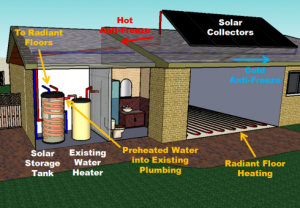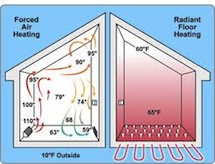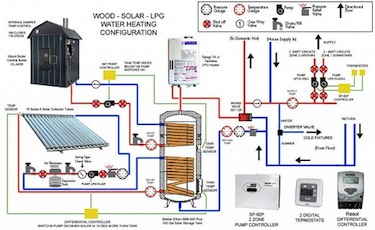Radiant Floor Heating

Radiant floor heating is known for its efficiency and comfort. While most radiant floor systems exist in the great white north, it is often a hard decision to include them in the Asheville and WNC climate. Some situations deserve them while most projects in our climate will struggle with their cost-effectiveness.
Many who have lived with radiant floor heating, insist on including it in their new home project based on their experience with its comfort. Sorry, but these experiences typically come from homes with poor performing building envelopes. If you can feel the radiant floor heat by touch, on an average winter day, the home is likely inefficient and was probably not proven airtight with a blower door test. Dont miss the most cost-effective opportunties.
 What is a Building Envelope?
What is a Building Envelope?  The Blower Door Test.
The Blower Door Test.
Energy efficient building envelopes almost eliminate feelings of warm feet. This is a good thing, it means less wasted energy. Some projects are only interested in radiant floors for bathrooms. This makes more sense for goals of warm feet, thanks to the limited area. We include radiant floor heating for clients that request it. This is information and opinions that I like to share with everyone regarding radiant floor heating.
Radiant Floors Are Less Comfortable
This common illustration is supposed to represent radiant floor heating versus forced-air. Once again, the comparison relies on a poorly built building envelope. Most people have experienced unpleasant forced-air systems. Modern, minimum code performance homes have very low CFM (air-flow) requirements. Professionally designed, installed and verified ducts, result in a forced-air system whose operation is barely noticeable.
Forced-air systems respond to thermostat changes quickly. Mood, state-of-rest, outdoor influence, individual preferences all benefit from quick changes in indoor-air temperature. Radiant floors are much slower to respond to thermostat changes based on occupant and environmental dynamics. Passive solar design is particularly vulnerable to radiant floor's thermostat response delay.
 Some radiant floors do better in this respect than others. This warmboard advertiser's video on FHB's site demonstrates how their system has quicker thermostat response than concrete or gypsum-based, embedded floor tubing. Its still important to note, that their system will have a slower response than forced-air. This reasoning calls into question the whole idea of radiant floors and high mass.
Some radiant floors do better in this respect than others. This warmboard advertiser's video on FHB's site demonstrates how their system has quicker thermostat response than concrete or gypsum-based, embedded floor tubing. Its still important to note, that their system will have a slower response than forced-air. This reasoning calls into question the whole idea of radiant floors and high mass.
Radiant Floors Do Not Provide Cooling
This is why radiant floor heating is not popular in the Southeast US climate. Most homes need to cool and de-humidify in our climate for part of the year and the only capable appliance is a heat pump. So if heat pumps are involved, why do you need to include radiant floor heating?
 There are many ways for keeping cool in the summertime without AC, but none of them include radiant floors.
There are many ways for keeping cool in the summertime without AC, but none of them include radiant floors.
Unless one has a high elevation building site, a means of cooling with de-humidification is needed to stay comfortable in our increasingly hot and humid summers. Buildings and furnishings also appreciate the less-humid conditions that we enjoy. Radiant floors do not cool or de-humidify.
How much do radiant floors cost?
Radiant floor heating is an expensive mechanical system. For an average 1600-2400 square foot home, expect $6,500-$35,000 for a typical radiant floor heating system. Radiant tubing installation in concrete slabs on grade are more affordable than tubing installed with wood framed floors. Much of the costs are in the heating appliance, circulators, plumbing parts, thermostats, and labor to assemble.
Even for heating-only projects, cost-effectiveness is a moving target
Dropping costs of solar PV, batteries, and increasing efficiencies of heat pumps are exciting developements in the green and high performance building movement. Economics continue to favor PV + heat pump over the inside combustion of natural gas and propane, fuels that radiant floors usually rely on.
For smart builders, still including radiant floors, the building envelope is still a primary focus. This electrodacus guy, seems to have achieved true off-grid (no fossil fuel assist) radiant floor heating in Canada for a very reasonable investment. Super efficient envelopes make electric resistance heating relevant again.
There are many investments better than radiant floor heating in our climate; air-sealing, insulation, choosing better windows, and more efficient heat pumps. These choices will save more money than radiant floors and make their perceived form of comfort more obsolete.
Radiant floor heating is energy efficient with many fuel choices.
Radiant floors are energy efficient ways to heat and are comparable in energy costs to high-efficiency air-source heat pumps and ground source heat pumps (geothermal). Almost any type of fuel can be used; solar, wood, Natural Gas NG, Propane LP, Fuel oil(#2 or Kerosene), solar PV, grid electricity or compost.
For those who are new or intimidated by heat pumps, its the same technology as your refrigerator. Air-source and ground-source heat pumps that supply energy to radiant floor systems are considered air-to-water or water-to-water technology, which do not provide cooling. Heat pumps which cool the air, need different technology (air-to-air or water-to-air).
The illustration to the right shows a theoritical radiant floor system powered by a compost pile. I use compost to pre-heat my domestic hot water and plan on attempting this pump-less, compost radiant floor system on my personal home's future renovation. Here is my compost water heater on a permaculture forum.
Solar Thermal Radiant Floor Heating
Solar thermal combined with radiant floor heating seems to be a perfect combination. It can work for some projects but for the majority, its usually not cost-effective. Check out our overview of solar energy if you are unfamiliar with the differences between; passive solar, solar thermal and photovoltaics PV.
If a building site has solar access for the collectors, it’s usually a good site for passive solar design; a more simple, effective and durable way to heat one’s home with the sun. A passive solar design with a proper building envelope will benefit little from solar thermal radiant floors because most of the heat will be supplied by the windows during sunny days but cloudy periods still require a backup fuel source. Unlike solar thermal radiant heating, passive solar design requires no maintenance or commissioning, has a zero failure rate, and boasts an unlimited lifespan. The strategy for getting around this design issue is big storage capacity. The CCHRC in Fairbanks has done the most work with these systems.
Many sites and existing homes don’t have the solar exposure needed for passive solar design but do have a good location for solar thermal collectors. It then makes more sense to invest in solar thermal radiant floors but they can be tough to make cost-effective. Many feel that solar thermal is dead.
Radiant floors combined with domestic hot water.
Many radiant floor systems use the heating appliance for their domestic hot water needs. These systems can make sense but they get complicated and perform poorly if not installed and commissioned appropriately. This is especially true when solar thermal assistance is involved.
These systems require the best available installers and builders to implement with success. Monitoring such a complicated system for expected performance is crucial. Homeowner involvement and maintenance is very important.
Radiant floors in high performance homes.
Heating appliances can be smaller. Tubing can be reduced and less than perfect floor tubing layout can be just as comfortable compared to a typical home. As with all heating and cooling systems, Manual J calculations should be used for system sizing.
In our climate, its arguably more cost-effective and eco-friendly to power efficient heat pumps with PV rather than supplying radiant heating with solar thermal. This is mainly due to the need to cool with dehumidification, the increasing efficiency of heat pumps and the decreasing costs of PV. The coming battery revolution should help too.
Radiant floor heating does have a place in some projects in our climate. High elevations, homes without AC, and special designs, like those with tall ceilings and walls of glass are situations that may want to include this form of efficient heating. Geothermal is another popular technology worth a shakedown.
 Geothermal, Ground Source Heat Pumps
Geothermal, Ground Source Heat Pumps  Heating and Cooling in WNC
Heating and Cooling in WNC  3 Forms of Solar Energy For Homes
3 Forms of Solar Energy For Homes
Springtime Builders are Asheville green home builders specializing in building science craftsmanship and indoor-air quality.
Posted in Heating and Cooling

